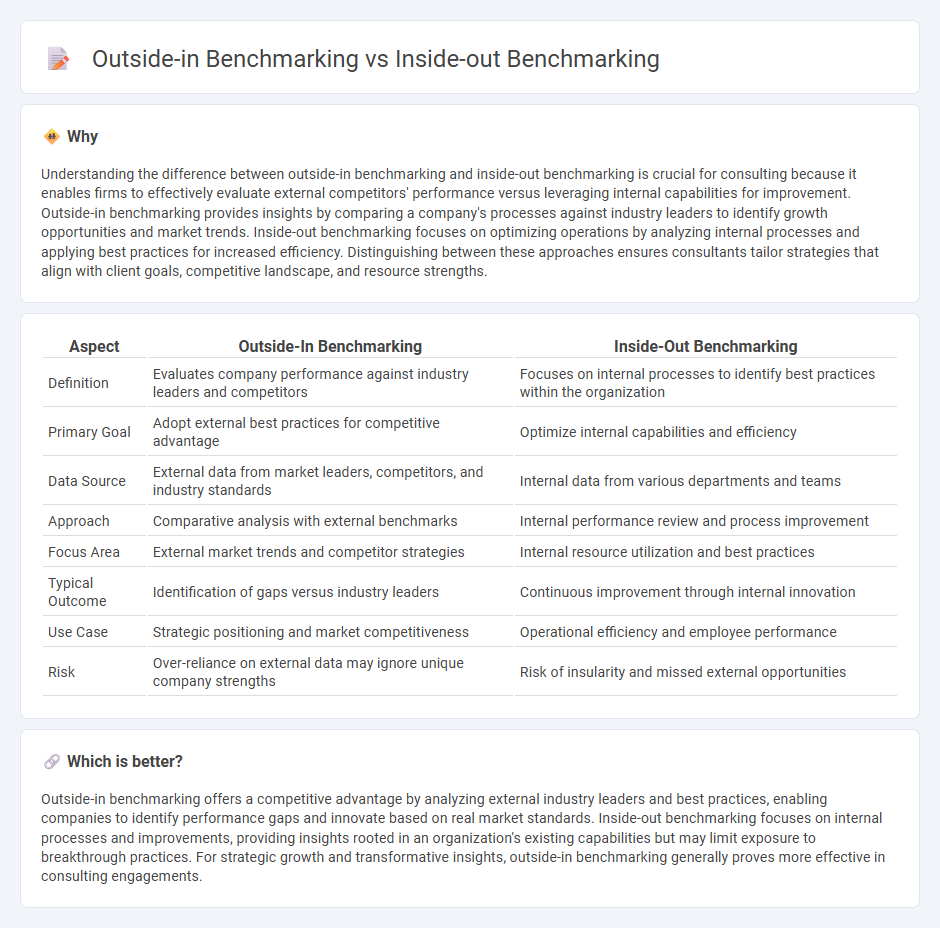
Outside-in benchmarking focuses on analyzing competitors and industry leaders to identify best practices and performance gaps, enhancing strategic decision-making by incorporating external insights. Inside-out benchmarking emphasizes evaluating internal processes and capabilities for continuous improvement and operational efficiency based on existing organizational data. Explore how these contrasting approaches can transform your consulting strategy for superior results.
Why it is important
Understanding the difference between outside-in benchmarking and inside-out benchmarking is crucial for consulting because it enables firms to effectively evaluate external competitors' performance versus leveraging internal capabilities for improvement. Outside-in benchmarking provides insights by comparing a company's processes against industry leaders to identify growth opportunities and market trends. Inside-out benchmarking focuses on optimizing operations by analyzing internal processes and applying best practices for increased efficiency. Distinguishing between these approaches ensures consultants tailor strategies that align with client goals, competitive landscape, and resource strengths.
Comparison Table
| Aspect | Outside-In Benchmarking | Inside-Out Benchmarking |
|---|---|---|
| Definition | Evaluates company performance against industry leaders and competitors | Focuses on internal processes to identify best practices within the organization |
| Primary Goal | Adopt external best practices for competitive advantage | Optimize internal capabilities and efficiency |
| Data Source | External data from market leaders, competitors, and industry standards | Internal data from various departments and teams |
| Approach | Comparative analysis with external benchmarks | Internal performance review and process improvement |
| Focus Area | External market trends and competitor strategies | Internal resource utilization and best practices |
| Typical Outcome | Identification of gaps versus industry leaders | Continuous improvement through internal innovation |
| Use Case | Strategic positioning and market competitiveness | Operational efficiency and employee performance |
| Risk | Over-reliance on external data may ignore unique company strengths | Risk of insularity and missed external opportunities |
Which is better?
Outside-in benchmarking offers a competitive advantage by analyzing external industry leaders and best practices, enabling companies to identify performance gaps and innovate based on real market standards. Inside-out benchmarking focuses on internal processes and improvements, providing insights rooted in an organization's existing capabilities but may limit exposure to breakthrough practices. For strategic growth and transformative insights, outside-in benchmarking generally proves more effective in consulting engagements.
Connection
Outside-in benchmarking involves analyzing competitors' best practices to identify external performance standards, while inside-out benchmarking focuses on evaluating internal processes to leverage organizational strengths. Their connection lies in integrating external insights with internal capabilities to drive continuous improvement and strategic alignment. This synergy enables businesses to adopt innovative solutions and enhance operational efficiency by comparing market benchmarks against internal performance metrics.
Key Terms
Internal Performance Metrics
Inside-out benchmarking emphasizes evaluating internal performance metrics such as productivity, efficiency, and process effectiveness to enhance an organization's operational capabilities. It prioritizes comparing current internal processes against historical data or industry standards to identify areas of improvement. Discover comprehensive strategies to optimize internal benchmarks and boost organizational performance.
Industry Best Practices
Inside-out benchmarking prioritizes internal processes and capabilities, leveraging existing data and performance metrics to identify improvement areas within the organization. Outside-in benchmarking focuses on Industry Best Practices by analyzing competitors and market leaders to adopt external strategies that drive superior outcomes. Explore how aligning both approaches can enhance operational excellence and competitive advantage.
Competitive Analysis
Inside-out benchmarking emphasizes evaluating internal processes and capabilities to improve competitive performance by leveraging existing strengths. Outside-in benchmarking focuses on analyzing competitors' strategies, market positioning, and customer preferences to identify opportunities and gaps. Explore detailed insights on how these approaches shape competitive analysis and strategic decision-making.
Source and External Links
Inside Out(r) launches a new framework to support in-house creative leadership - Inside-Out benchmarking here refers to a diagnostic and professional development tool that helps in-house creative leaders evaluate their team's maturity and leadership capabilities by reflecting on their current position and growth potential within an organization-specific framework.
Benchmarking -- Inside and Out - Facilities Management - Inside-out benchmarking means using internal benchmarks to analyze and compare performance within an organization's own units or facilities, allowing discovery of underlying causes and sharing of best practices, as opposed to comparing only with external entities.
Sourcing Inside Out: Benchmarking Clauses that Work - Inside-out benchmarking is viewed as part of a strategic governance process in outsourcing relationships, where reviewing internal performance leads to constructive, future-oriented improvements rather than just cost-cutting based on past performance.
 dowidth.com
dowidth.com